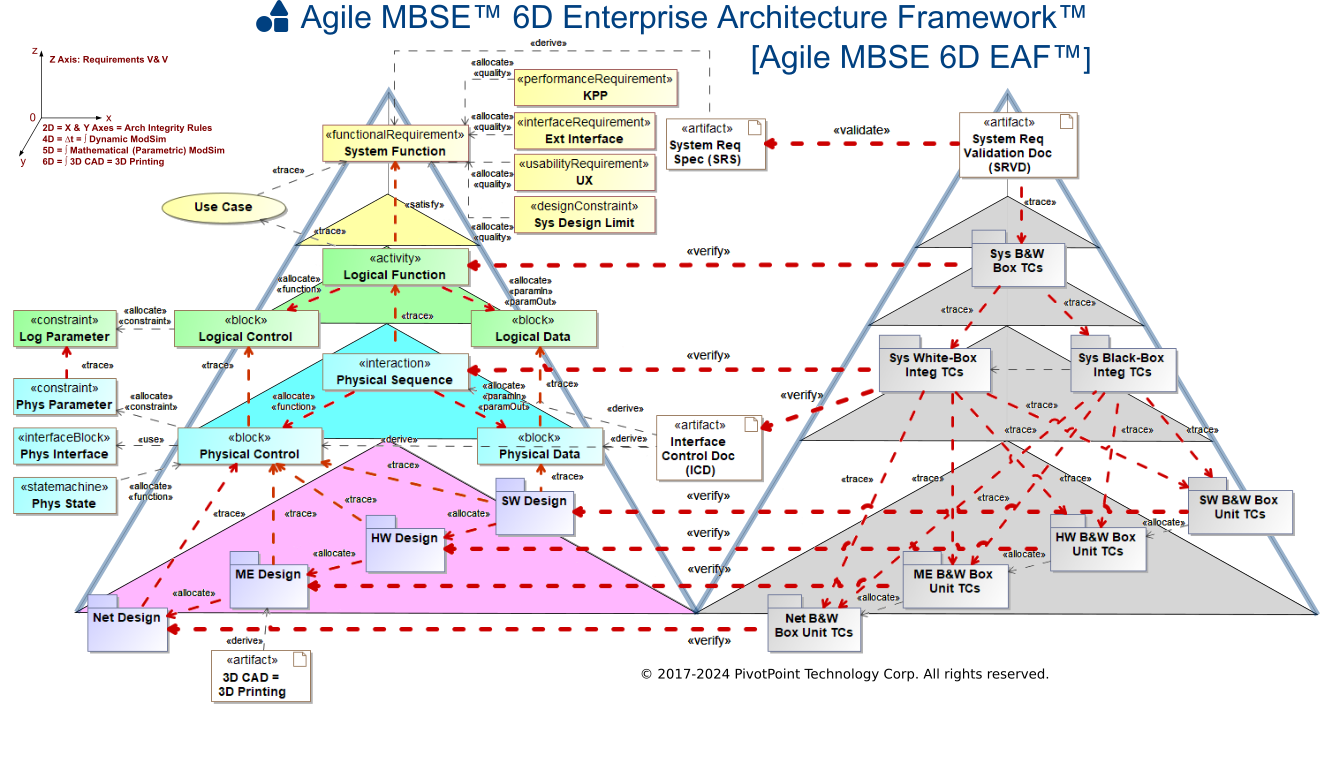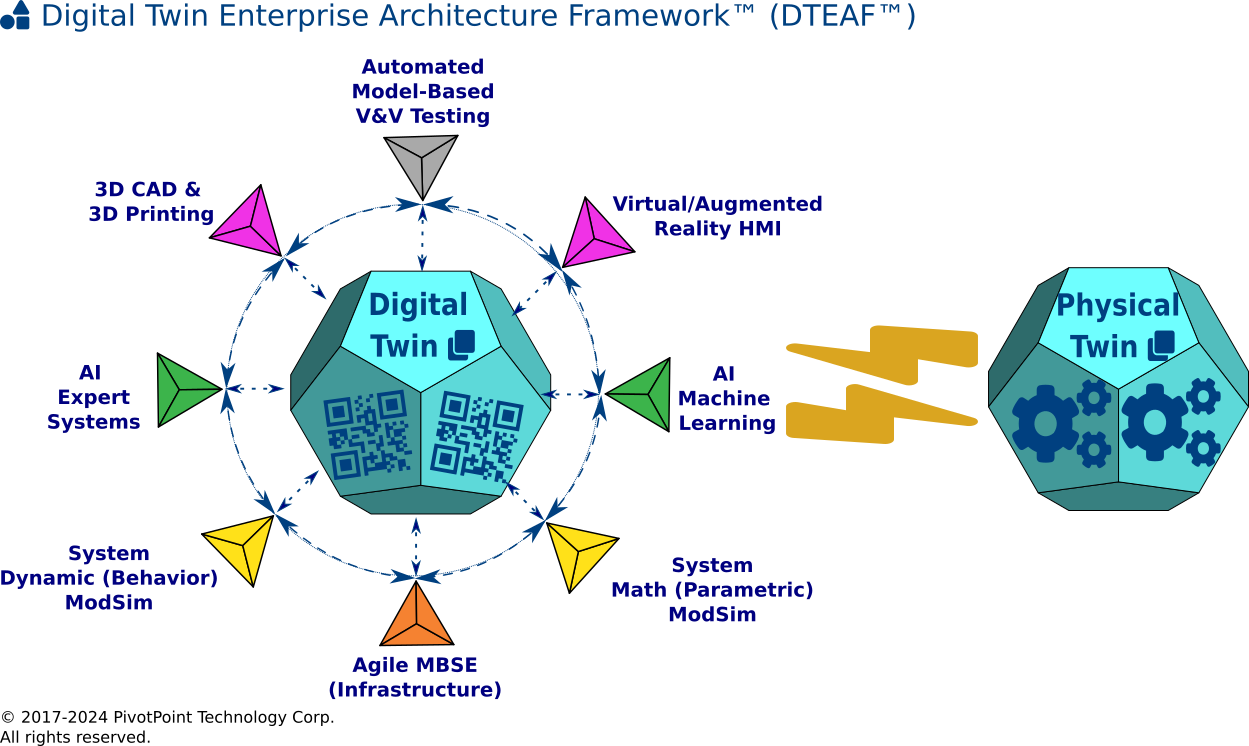PivotPoint FAQ: What is the Agile MBSE 6D Enterprise Architecture Framework™?
PivotPoint FAQ: What is Agile MBSE 6D Enterprise Architecture Framework™ (Agile MBSE 6D EAF™)?
FAQ Variant(s): How does the Agile MBSE 6D EAF improve the traditional System-V Model?
Although the traditional System-V Model may be useful for summarizing Systems Engineering (SE) System Development Life Cycle (SDLC) concepts and terminology for practitioners, it fails to do much more than that. Given its numerous shortcomings (e.g., it is inherently sequential, whereas real-world SE processes tend to be concurrent or pipelined; it is inherently 2D and flat, whereas real-world SE Systems-of-Systems tend to be multi-dimensional and fractal), it has lived long past its usefulness. Indeed, one could argue that it is causing more harm than good since it gives Systems Engineers a naive and misleading concept about how to manage the size and complexity of Systems-of-Systems, which are increasing in size and complexity at an exponential rate (see Augustine's Law XVI).
Whereas the traditional SE System-V model is conceptual, architecturally-ignorant, ad hoc, 2-dimensional, and waterfall-sequential, the Agile MBSE 6D Enterprise Architecture Framework EAF™ (Agile MBSE 6D EAF™) is detailed, architecture-centric, pattern-based, multi-dimensional, and concurrent. The Agile MBSE 6D EAF offers 4 abstraction-level projections («views») on the left-hand side (LHS) tetrahedron for transitive requirement traceability patterns, and 3 abstraction-level projections («views») on the right-hand side (RHS) tetrahedron for Verification & Validation (V&V) patterns.
The «view» projections for the LHS tetrahedron are best thought of as "top-down" and include: Requirements Analysis «view», System Analysis «view» (a.k.a., Operational «view»), High-Level System Design «view», and Low-Level System Design «view», with the Implementation «view» at the bottom, shared by both tetrahedrons. The LHS «views» facilitate a transitive requirements trace pattern in that any arbitrary Functional Requirement in the Requirements Analysis «view» can be satisfied by one or more simulatable Activity functions in the System Analysis «view», which in turn can be traced to one or more simulatable Interactions (Sequences) in the High-Level System Design «view», which can subsequently be traced to one or more detailed Interactions in the Low-Level System Design «view», that can be further refined into one or more Implementation Interactions in the bottom Implementation «view» shared by both tetrahedrons.
The «view» projections for the RHS tetrahedron are best thought of as "bottom-up" (in reverse; cf. push stack on the LHS, and pop stack on the RHS) and include: Unit Test Case «view» at the bottom, Integration Test Case «view» in the middle, and System Test Case «view» at the top. The RHS «views» facilitate a transitive V&V pattern in that any arbitrary black-box and white-box Unit Test Case is rolled up into a black-box/white-box Integration Test Case, which in turn is rolled up into a black-box/white-box System Test Case.
For more information about the Agile MBSE 6D EAF and how it can help scale and simulate your MBSE or Digital Engineering project, contact us.
Whereas the traditional SE System-V model is conceptual, architecturally-ignorant, ad hoc, 2-dimensional, and waterfall-sequential, the Agile MBSE 6D Enterprise Architecture Framework EAF™ (Agile MBSE 6D EAF™) is detailed, architecture-centric, pattern-based, multi-dimensional, and concurrent. The Agile MBSE 6D EAF offers 4 abstraction-level projections («views») on the left-hand side (LHS) tetrahedron for transitive requirement traceability patterns, and 3 abstraction-level projections («views») on the right-hand side (RHS) tetrahedron for Verification & Validation (V&V) patterns.
The «view» projections for the LHS tetrahedron are best thought of as "top-down" and include: Requirements Analysis «view», System Analysis «view» (a.k.a., Operational «view»), High-Level System Design «view», and Low-Level System Design «view», with the Implementation «view» at the bottom, shared by both tetrahedrons. The LHS «views» facilitate a transitive requirements trace pattern in that any arbitrary Functional Requirement in the Requirements Analysis «view» can be satisfied by one or more simulatable Activity functions in the System Analysis «view», which in turn can be traced to one or more simulatable Interactions (Sequences) in the High-Level System Design «view», which can subsequently be traced to one or more detailed Interactions in the Low-Level System Design «view», that can be further refined into one or more Implementation Interactions in the bottom Implementation «view» shared by both tetrahedrons.
The «view» projections for the RHS tetrahedron are best thought of as "bottom-up" (in reverse; cf. push stack on the LHS, and pop stack on the RHS) and include: Unit Test Case «view» at the bottom, Integration Test Case «view» in the middle, and System Test Case «view» at the top. The RHS «views» facilitate a transitive V&V pattern in that any arbitrary black-box and white-box Unit Test Case is rolled up into a black-box/white-box Integration Test Case, which in turn is rolled up into a black-box/white-box System Test Case.
For more information about the Agile MBSE 6D EAF and how it can help scale and simulate your MBSE or Digital Engineering project, contact us.
© 2003-2024 PivotPoint Technology Corp. | Terms of Use | Privacy | Contact Us
PIVOTPOINT TECHNOLOGY, AGILE MBSE, MODEL-BASED DIGITAL ENGINEERING + AI, SYSML MBSE EXPERT AI COPILOT, SMEAC, SYSTEM ARCHITECTURE AS A SERVICE, SAAAS, ESSENTIAL AGILE ARCHITECTURE + UML 2 APPLIED, ESSENTIAL MBSE + SYSML APPLIED, ESSENTIAL BPM + BPMN APPLIED, AGILE DODAF 2 + UML 2 APPLIED, AGILE DODAF 2 + SYSML APPLIED, AGILEML, AGILE MODELING LANGUAGE, CYBERML, and CYBER MODELING LANGUAGE are trademarks of PivotPoint Technology Corp.
UML, BPMN, OMG SYSML, and UPDM are trademarks of the Object Management Group.
ENTERPRISE ARCHITECT is a trademark of Sparx Systems Pty Ltd. MAGICDRAW and CAMEO are trademarks of No Magic, Inc. RATIONAL RHAPSODY is a trademark of IBM.
All other trademarks are the property of their respective owners.
UML, BPMN, OMG SYSML, and UPDM are trademarks of the Object Management Group.
ENTERPRISE ARCHITECT is a trademark of Sparx Systems Pty Ltd. MAGICDRAW and CAMEO are trademarks of No Magic, Inc. RATIONAL RHAPSODY is a trademark of IBM.
All other trademarks are the property of their respective owners.

